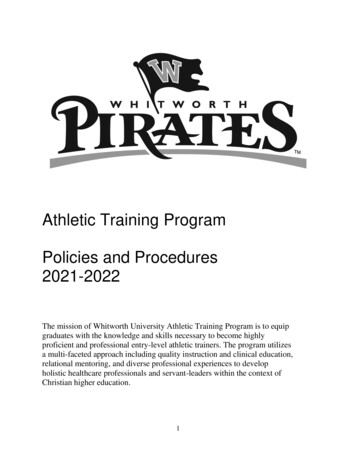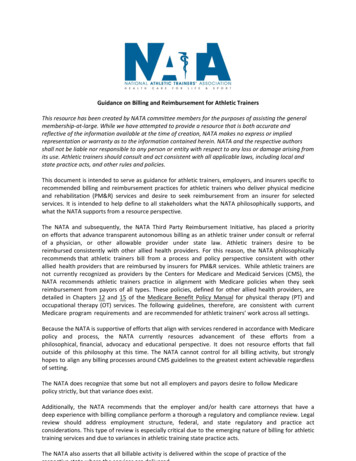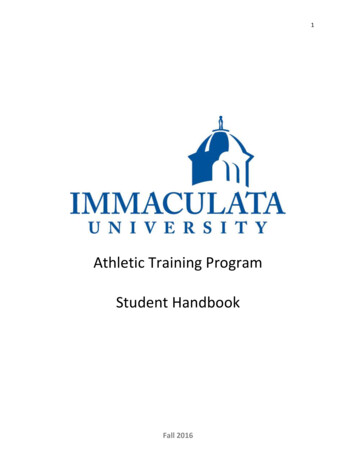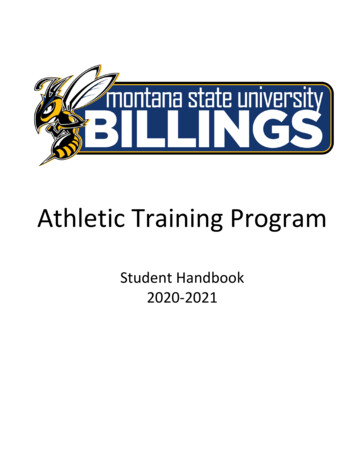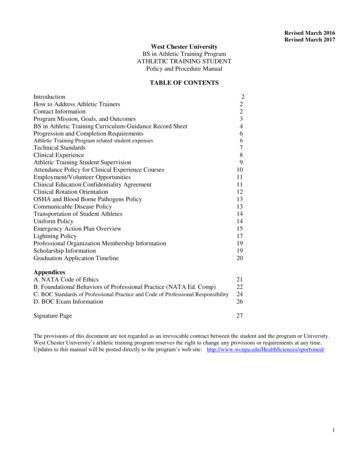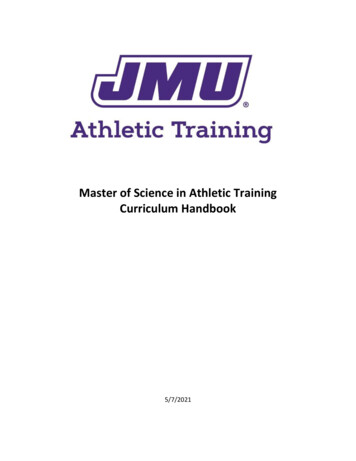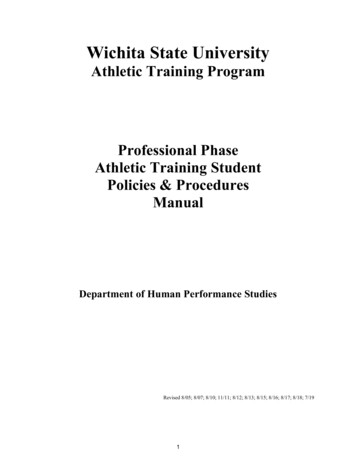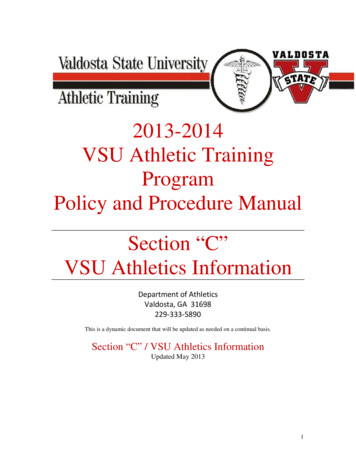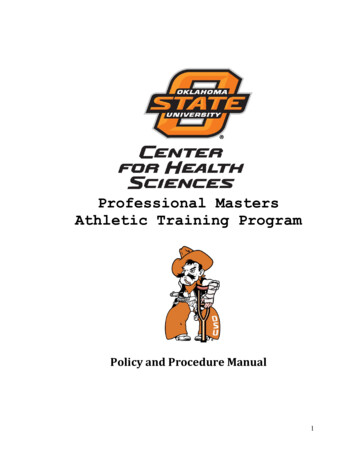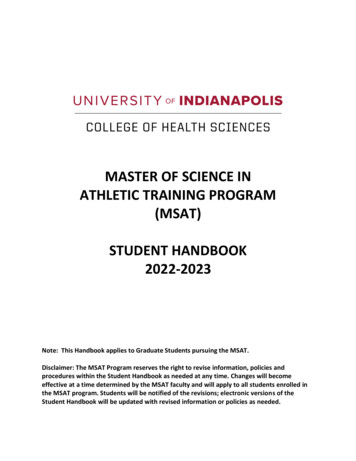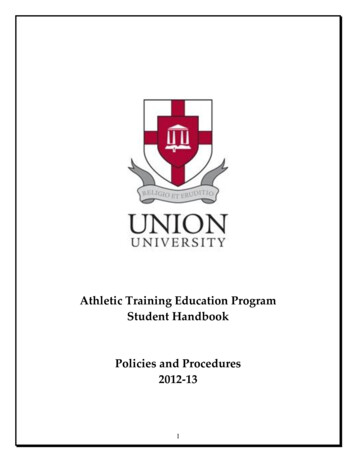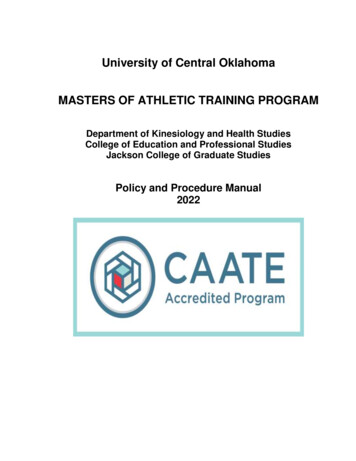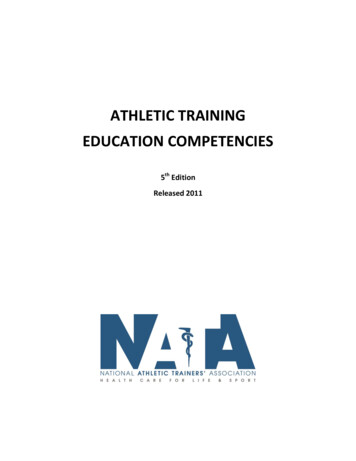
Transcription
ATHLETIC TRAININGEDUCATION COMPETENCIES5th EditionReleased 2011
Table of ContentsPreface2Foundational Behaviors of Professional Practice3Introduction4thSummary of Major Changes Included in 5 Edition5Comparison of the Role Delineation Study/Practice Analysis, 6th Ed, and the Competencies6Project Team Members7Foundational Behaviors of Professional Practice9Content AreasEvidence-Based Practice11Prevention and Health Promotion13Clinical Examination and Diagnosis17Acute Care of Injury and Illness20Therapeutic Interventions23Psychosocial Strategies and Referral27Healthcare Administration29Professional Development and Responsibility31Clinical Integration Proficiencies National Athletic Trainers’ Association322
PrefaceThe 5th edition of the Athletic Training Education Competencies (Competencies) provides educationalprogram personnel and others with the knowledge, skills, and clinical abilities to be mastered bystudents enrolled in professional athletic training education programs. Mastery of these Competenciesprovides the entry–level athletic trainer with the capacity to provide athletic training services to clientsand patients of varying ages, lifestyles, and needs.The Commission on Accreditation of Athletic Training Education (CAATE) requires that the Competenciesbe instructed and evaluated in each accredited professional athletic training education program. TheCompetencies serve as a companion document to the accreditation standards, which identify therequirements to acquire and maintain accreditation, published by CAATE.The Professional Education Council (PEC) of the NATA was charged with creating the 5th edition of theCompetencies. The PEC developed and executed a systematic plan to draft the Competencies and tosolicit and integrate feedback from multiple sources as the draft was revised. First, the PEC orchestratedan initial open call for feedback on the 4th edition of the Competencies. Next, groups of subject-matterexperts, including practicing athletic trainers, educators, and administrators, were identified. In additionto the feedback on the 4th edition, these subject-matter experts considered today’s healthcare system,current best practice in athletic training, and their own expertise in creating an initial draft of the 5thedition. Many conversations ensued and subsequent drafts were submitted. Following revision for formand consistency of language, a draft of the Competencies was again posted for open feedback. Thisvaluable feedback was considered in its entirety by the PEC, and final revisions were made.We thank the members of the PEC for their untiring efforts in revising this document to reflect thechanging needs of athletic training education. The advice, cooperation, and feedback from the Board ofCertification and the CAATE have also been instrumental in this process. Finally, the diligent andperceptive feedback that was received from stakeholders during the public comment periods wasinstrumental in creating a document that ensures that entry-level athletic trainers are prepared to workin a changing healthcare system. Together we are improving healthcare by improving the education ofathletic trainers.- NATA Executive Committee for Education, December 2010 National Athletic Trainers’ Association3
IntroductionThis document is to be used as a guide by administrative, academic, and clinical program personnelwhen structuring all facets of the education experience for students. Educational program personnelshould recognize that the Competencies are the minimum requirements for a student’s professionaleducation. Athletic training education programs are encouraged to exceed these minimums to providetheir students with the highest quality education possible. In addition, programs should employinnovative, student-centered teaching and learning methodologies to connect the classroom, laboratoryand clinical settings whenever possible to further enhance professional preparation.The acquisition and clinical application of knowledge and skills in an education program must representa defined yet flexible program of study. Defined in that knowledge and skills must be accounted for inthe more formal classroom and laboratory educational experience. Flexible in that learningopportunities are everywhere. Behaviors are identified, discussed, and practiced throughout theeducational program. Whatever the sequence of learning, patient safety is of prime importance;students must demonstrate competency in a particular task before using it on a patient. This begins acycle of learning, feedback, refinement, and more advanced learning. Practice with concepts by gainingclinical experience with real life applications readies the student for opportunities to demonstratedecision-making and skill integration ability, Clinical Integrated Proficiencies (CIP). CIPs are designed tomeasure of real life application. Students should be assessed in their performance of CIPs on actualpatients. If this is not possible, standardized/simulated patients or scenarios should be used to measurestudent proficiency.Also, inherent in this document is the understanding that a comprehensive basic and applied sciencebackground is needed for students to develop appropriate levels of professional competence in thediscipline-specific knowledge and skills described in this document.All facets of the educational programs must incorporate current knowledge and skills that representbest practice. Programs must select such content following careful review of the research literature andconsideration of the needs for today’s entry-level practitioner. Because the knowledge within aprofession is dynamic, information regarding current best practice is fluid and requires on-goingexamination and reflection. National Athletic Trainers’ Association4
SUMMARY OF MAJOR CHANGES INCLUDED IN 5TH EDITION The 12 content areas of the previous edition have been reorganized into 8 to eliminateredundancies and better reflect current practice.oThe pathology content area was eliminated, and these competencies are addressedthroughout other content areas.oThe risk management/prevention and nutritional considerations content areas werecombined to form the new Prevention and Health Promotion (PHP) content area. Thischange was made to reflect the current emphasis on prevention and wellness acrosshealth care and the lifespan.oThe orthopedic clinical exam/diagnosis and medical conditions/disabilities content areaswere combined to form the Clinical Examination and Diagnosis (CE) content area. Thischange was made to emphasize that athletic trainers use one standard clinicalexamination model that changes based on the findings and needs of the patient.oThe therapeutic modalities, conditioning and rehabilitative exercise and pharmacologycontent areas were combined to form one content area that incorporates all aspects ofTherapeutic Interventions (TI).oA new content area was added to provide students with the basic knowledge and skillsrelated to Evidence-Based Practice (EBP). The importance of using EBP concepts andprinciples to improve patient outcomes is being emphasized throughout the health caresystem and is reflected within this new content area.The Acute Care (AC) content area has been substantially revised to reflect contemporarypractice.oThe addition of skill in assessing rectal temperature, oxygen saturation, blood glucoselevels, and use of a nebulizer and oropharyngeal and nasopharyngeal airways reflectsrecommendations of NATA position statements that are published or in development. The content areas now integrate knowledge and skills, instead of separate sections for cognitiveand psychomotor competencies. The action verb used in each competency statement identifiesthe expected outcome. In some places, knowledge is the expectation and not skill acquisition.For example, acute care competency #9 (AC-9) requires that athletic training students beknowledgeable about the various types of airway adjuncts including oropharyngeal airways(OPA), nasopharyngeal airways (NPO) and supraglottic airways. However, the accompanying skillcompetency AC-10 does not require skill acquisition in the use of the supraglottic airways. The Clinical Integration Proficiencies (CIP), which are ideally assessed in the context of realpatient care, have been removed from the individual content areas and reorganized into aseparate section. This reorganization reflects clinical practice and demonstrates the globalnature of the Proficiencies. For example, rather than just assessing students’ ability to examine areal patient in a real clinical setting, the new CIPs require that students demonstrate the abilityto examine and diagnose a patient, provide appropriate acute/emergent care, plan andimplement appropriate therapeutic interventions, and make decisions pertaining to safe returnto participation. This approach to student assessment better reflects the comprehensive natureof real patient care. National Athletic Trainers’ Association5
COMPARISON OF THE ROLE DELINEATION STUDY/PRACTICE ANALYSIS, 6TH ED AND THECOMPETENCIESThe Role Delineation Study/Practice Analysis, 6th ed (RDS/PA) of the Board of Certification serves as theblue print for the certification examination. As such, the Competencies must include all tasks (andrelated knowledge and skills) included in the RDS/PA. Working with the BOC, we compared the RDS/PAwith this version of the Competencies and can confidently state that the content of the RDS /PA isincorporated in this version. National Athletic Trainers’ Association6
5TH EDITION COMPETENCIES – PROJECT TEAM MEMBERSProfessional Education Council: Lou Fincher, EdD, ATC- ChairDavid W. Carr, PhD, ATC; Ron Courson, ATC, PT, NREMT; Jolene Henning, EdD, ATC; Marsha Grant-Ford, PhD, ATC;Luzita Vela, PhD, ATC; Alice Wilcoxson, PhD, ATC, PTRisk Management &Injury PreventionTeam Leader: Lou FincherOrthopedic Clinical Assessment &DiagnosisTeam Leader: Jolene HenningMedical Conditions & DisabilitiesDoug Casa, PhD, ATC, FACSMUniversity of ConnecticutSara Brown, MS, ATCBoston UniversityMicki Cuppett, EdD, ATCUniversity of South FloridaPaula Maxwell, PhD, ATCJames Madison UniversityWes Robinson, ATCUniversity of MarylandRandy Cohen, ATC, DPTUniversity of ArizonaJim Schilling, PhD, ATC, CSCSUniversity of Southern MaineDoug Gregory, MD, FAAPSuffolk, VAChad Starkey, PhD, ATCOhio UniversityKatie Walsh, EdD, ATCEast Carolina UniversityTherapeutic Modalities /Conditioning & Rehabilitative ExerciseTeam Leaders: Luzita Vela &Marsha Grant FordPharmacologyDean Crowell, MA, ATC, NREMT-BAthens Ortho ClinicCraig Denegar, PhD, ATC, PTUniversity of ConnecticutMicki Cuppett, EdD, ATCUniversity of South FloridaGianluca Del Rossi, PhD, ATCUniversity of South FloridaLennart Johns, PhD, ATCQuinnipiac UniversityDoug Gregory, MD, FAAPSuffolk, VAMichael Dillon, ATCUniversity of GeorgiaKen Knight, PhD, ATC, FACSMBrigham Young UniversityJoel Houglum, PhDSouth Dakota State UniversityJim Ellis, MDGreenville, SCSayers John Miller, PhD, ATC, PTPennsylvania State UniversityGreg Keuter, ATCSportPharmFrancis Feid, Med, MS, ATC, CRNAPittsburgh, PAMark Merrick, PhD, ATCOhio State UniversityDiedre Leaver Dunn, PhD, ATCUniversity of AlabamaKevin Guskiewicz, PhD, ATCUNC-Chapel HillCindy Trowbridge, PhD, ATC, LATUniversity of Texas – ArlingtonGlen Henry, MS, NREMT-PAthens Technical CollegeCraig Voll, ATCPurdue UniversityAcute Care of Injuries & IllnessesTeam Leader: Ron CoursonTeam Leader: David CarrTeam Leader: David CarrMaryBeth Horodyski, EdD, ATCUniversity of FloridaJim Kyle, MDMorgantown, WVRobb Rehberg, PhD, ATC, NREMTWilliam Paterson UniversityErik Swartz, PhD, ATCUniversity of New Hampshire National Athletic Trainers’ Association7
Psychosocial Intervention & ReferralTeam Leader: Alice WilcoxsonNutritional Aspects of Injuries &IllnessesTeam Leader: Alice WilcoxsonHealth Care AdministrationTeam Leader: Jolene HenningMegan D. Granquist, PhD, ATCUniversity of La VerneLeslie Bonci, RD, MPH, LDNUniversity of PittsburghKathy Dieringer, EdD, ATCSports Med, DentonJ. Jordan Hamson-Utley, PhD, ATCWeber State UniversityTina Bonci, ATCUniversity of TexasLinda Mazzoli, MS, ATC, PTACooper Bone & Joint InstituteLaura J. Kenow, MS, ATCLinfield CollegeRachel Clark, RD, CSSDPurdue UniversityRich Ray, EdD, ATCHope CollegeDiane Wiese-BjornstalUniversity of MinnesotaPaula Sammarone Turocy, EdD, ATCDuquesne UniversityJames Shipp, MA, ATCTowson UniversityDawn Weatherwax-Fall, RD, CSSD, LD,ATC, CSCSSports Nutrition 2Go!Ingrid Skoog, RD, CSSDOregon State UniversityProfessional DevelopmentTeam Leader: Marsha Grant-FordEvidence-Based PracticeTeam Leader: Luzita VelaBill Biddington, EdD, ATCCalifornia University of PennsylvaniaCraig Denegar, PhD, ATC, PTUniversity of ConnecticutTodd Evans, PhD, ATCUniversity of Northern IowaJay Hertel, PhD, ATCUniversity of VirginiaJennifer Hootman, PhD, ATCCenters for Disease Control &PreventionLori Michener, PT, PhD, ATC, SCSVirginia Commonwealth UniversityJohn Parsons, PhD, ATCAT Still UniversityEric Sauers, PhD, ATC, FNATAAT Still UniversityBonnie Van Lunen, PhD, ATCOld Dominion University National Athletic Trainers’ Association8
Foundational Behaviors of Professional PracticeThese basic behaviors permeate professional practice and should be incorporated into instruction andassessed throughout the educational program.Primacy of the Patient Recognize sources of conflict of interest that can impact the client’s/patient’s health. Know and apply the commonly accepted standards for patient confidentiality. Provide the best healthcare available for the client/patient. Advocate for the needs of the client/patient.Team Approach to Practice Recognize the unique skills and abilities of other healthcare professionals. Understand the scope of practice of other healthcare professionals. Execute duties within the identified scope of practice for athletic trainers. Include the patient (and family, where appropriate) in the decision-making process. Work with others in effecting positive patient outcomes.Legal Practice Practice athletic training in a legally competent manner. Identify and conform to the laws that govern athletic training. Understand the consequences of violating the laws that govern athletic training.Ethical Practice Comply with the NATA’s Code of Ethics and the BOC’s Standards of Professional Practice. Understand the consequences of violating the NATA’s Code of Ethics and BOC’s Standards ofProfessional Practice. Comply with other codes of ethics, as applicable.Advancing Knowledge Critically examine the body of knowledge in athletic training and related fields. Use evidence-based practice as a foundation for the delivery of care. Appreciate the connection between continuing education and the improvement of athletictraining practice. Promote the value of research and scholarship in athletic training. Disseminate new knowledge in athletic training to fellow athletic trainers, clients/patients, otherhealthcare professionals, and others as necessary. National Athletic Trainers’ Association9
Cultural Competence Demonstrate awareness of the impact that clients’/patients’ cultural differences have on theirattitudes and behaviors toward healthcare. Demonstrate knowledge, attitudes, behaviors, and skills necessary to achieve optimal healthoutcomes for diverse patient populations. Work respectfully and effectively with diverse populations and in a diverse work environment.Professionalism Advocate for the profession. Demonstrate honesty and integrity. Exhibit compassion and empathy. Demonstrate effective interpersonal communication skills. National Athletic Trainers’ Association10
Evidence-Based Practice (EBP)Evidence-based practitioners incorporate the best available evidence, their clinical skills, and the needsof the patient to maximize patient outcomes. An understanding of evidence-based practice conceptsand their application is essential to sound clinical decision-making and the critical examination ofathletic training practice.Practicing in an evidence-based manner should not be confused with conducting research. Whileconducting research is important to the profession of athletic training, developing the ability to conducta research project is not an expectation of professional education. This section focuses on theknowledge and skills necessary for entry-level athletic trainers to use a systematic approach to ask andanswer clinically relevant questions that affect patient care by using review and application of existingresearch evidence. One strategy, among others, is to use a five-step approach: 1) creating a clinicallyrelevant question; 2) searching for the best evidence; 3) critically analyzing the evidence; 4) integratingthe appraisal with personal clinical expertise and patients’ preferences; and 5) evaluating theperformance or outcomes of the actions. Each competency listed below is related to such a systematicapproach and provides the building blocks for employing evidence-based practice. Other specificevidence-based practice competencies have also been included in appropriate content areas.All items listed in parentheses (eg) are intended to serve as examples and are not all encompassing orthe only way to satisfy the competency.KNOWLEDGE AND SKILLSEBP-1. Define evidence-based practice as it relates to athletic training clinical practice.EBP-2. Explain the role of evidence in the clinical decision making process.EBP-3. Describe and differentiate the types of quantitative and qualitative research, researchcomponents, and levels of research evidence.EBP-4. Describe a systematic approach (eg, five step approach) to create and answer a clinicalquestion through review and application of existing research.EBP-5. Develop a relevant clinical question using a pre-defined question format (eg, PICO Patients, Intervention, Comparison, Outcomes; PIO Patients, Intervention, Outcomes).EBP-6. Describe and contrast research and literature resources including databases and onlinecritical appraisal libraries that can be used for conducting clinically-relevant searches.EBP-7. Conduct a literature search using a clinical question relevant to athletic training practiceusing search techniques (eg, Boolean search, Medical Subject Headings) and resourcesappropriate for a specific clinical question.EBP-8. Describe the differences between narrative reviews, systematic reviews, and metaanalyses.EBP-9. Use standard criteria or developed scales (eg, Physiotherapy Evidence Database Scale[PEDro], Oxford Centre for Evidence Based Medicine Scale) to critically appraise thestructure, rigor, and overall quality of research studies.EBP-10. Determine the effectiveness and efficacy of an athletic training intervention utilizingevidence-based practice concepts. National Athletic Trainers’ Association11
EBP-11. Explain the theoretical foundation of clinical outcomes assessment (eg, disablement,health-related quality of life) and describe common methods of outcomes assessment inathletic training clinical practice (generic, disease-specific, region-specific, and dimensionspecific outcomes instruments).EBP-12. Describe the types of outcomes measures for clinical practice (patient-based and clinicianbased) as well as types of evidence that are gathered through outcomes assessment(patient-oriented evidence versus disease-oriented evidence).EBP-13. Understand the methods of assessing patient status and progress (eg, global rating ofchange, minimal clinically important difference, minimal detectable difference) with clinicaloutcomes assessments.EBP-14. Apply and interpret clinical outcomes to assess patient status, progress, and change usingpsychometrically sound outcome instruments. National Athletic Trainers’ Association12
Prevention and Health Promotion (PHP)Athletic trainers develop and implement strategies and programs to prevent the incidence and/orseverity of injuries and illnesses and optimize their clients’/patients’ overall health and quality of life.These strategies and programs also incorporate the importance of nutrition and physical activity inmaintaining a healthy lifestyle and in preventing chronic disease (eg, diabetes, obesity, cardiovasculardisease).KNOWLEDGE AND SKILLSGeneral Prevention PrinciplesPHP-1.Describe the concepts (eg, case definitions, incidence versus prevalence, exposureassessment, rates) and uses of injury and illness surveillance relevant to athletic training.PHP-2.Identify and describe measures used to monitor injury prevention strategies (eg, injuryrates and risks, relative risks, odds ratios, risk differences, numbers needed to treat/harm).PHP-3.Identify modifiable/non-modifiable risk factors and mechanisms for injury and illness.PHP-4.Explain how the effectiveness of a prevention strategy can be assessed using clinicaloutcomes, surveillance, or evaluation data.PHP-5.Explain the precautions and risk factors associated with physical activity in persons withcommon congenital and acquired abnormalities, disabilities, and diseases.PHP-6.Summarize the epidemiology data related to the risk of injury and illness associated withparticipation in physical activity.Prevention Strategies and ProceduresPHP-7.Implement disinfectant procedures to prevent the spread of infectious diseases and tocomply with Occupational Safety and Health Administration (OSHA) and other federalregulations.PHP-8.Identify the necessary components to include in a preparticipation physical examination asrecommended by contemporary guidelines (eg, American Heart Association, AmericanAcademy of Pediatrics Council on Sports Medicine & Fitness).PHP-9.Explain the role of the preparticipation physical exam in identifying conditions that mightpredispose the athlete to injury or illness.PHP-10. Explain the principles of the body’s thermoregulatory mechanisms as they relate to heatgain and heat loss.PHP-11. Explain the principles of environmental illness prevention programs to include acclimationand conditioning, fluid and electrolyte replacement requirements, proper practice andcompetition attire, hydration status, and environmental assessment (eg, slingpsychrometer, wet bulb globe temperatures [WBGT], heat index guidelines).PHP-12. Summarize current practice guidelines related to physical activity during extreme weatherconditions (eg, heat, cold, lightning, wind).PHP-13. Obtain and interpret environmental data (web bulb globe temperature [WBGT], slingpsychrometer, lightning detection devices) to make clinical decisions regarding thescheduling, type, and duration of physical activity. National Athletic Trainers’ Association13
PHP-14. Assess weight loss and hydration status using weight charts, urine color charts, or specificgravity measurements to determine an individual’s ability to participate in physical activityin a hot, humid environment.PHP-15. Use a glucometer to monitor blood glucose levels, determine participation status, andmake referral decisions.PHP-16. Use a peak-flow meter to monitor a patient’s asthma symptoms, determine participationstatus, and make referral decisions.PHP-17. Explain the etiology and prevention guidelines associated with the leading causes ofsudden death during physical activity, including but not limited to:PHP-17a. Cardiac arrhythmia or arrestPHP-17b. AsthmaPHP-17c. Traumatic brain injuryPHP-17d. Exertional heat strokePHP-17e. HyponatremiaPHP-17f. Exertional sicklingPHP-17g. Anaphylactic shockPHP-17h. Cervical spine injuryPHP-17i. Lightning strikePHP-18. Explain strategies for communicating with coaches, athletes, parents, administrators, andother relevant personnel regarding potentially dangerous conditions related to theenvironment, field, or playing surfaces.PHP-19. Instruct clients/patients in the basic principles of ergodynamics and their relationship tothe prevention of illness and injury.Protective Equipment and Prophylactic ProceduresPHP-20. Summarize the basic principles associated with the design, construction, fit, maintenance,and reconditioning of protective equipment, including the rules and regulations establishedby the associations that govern its use.PHP-21. Summarize the principles and concepts related to the fabrication, modification, andappropriate application or use of orthotics and other dynamic and static splints.PHP-22. Fit standard protective equipment following manufacturers’ guidelines.PHP-23. Apply preventive taping and wrapping procedures, splints, braces, and other specialprotective devices.Fitness/WellnessPHP-24. Summarize the general principles of health maintenance and personal hygiene, includingskin care, dental hygiene, sanitation, immunizations, avoidance of infectious andcontagious diseases, diet, rest, exercise, and weight control.PHP-25. Describe the role of exercise in maintaining a healthy lifestyle and preventing chronicdisease. National Athletic Trainers’ Association14
PHP-26. Identify and describe the standard tests, test equipment, and testing protocols that areused for measuring fitness, body composition, posture, flexibility, muscular strength,power, speed, agility, and endurance.PHP-27. Compare and contrast the various types of flexibility, strength training, and cardiovascularconditioning programs to include expected outcomes, safety precautions, hazards, andcontraindications.PHP-28. Administer and interpret fitness tests to assess a client’s/patient’s physical status andreadiness for physical activity.PHP-29. Explain the basic concepts and practice of fitness and wellness screening.PHP-30. Design a fitness program to meet the individual needs of a client/patient based on theresults of standard fitness assessments and wellness screening.PHP-31. Instruct a client/patient regarding fitness exercises and the use of muscle strengtheningequipment to include correction or modification of inappropriate, unsafe, or dangerouslifting techniques.General Nutrition ConceptsPHP-32. Describe the role of nutrition in enhancing performance, preventing injury or illness, andmaintaining a healthy lifestyle.PHP-33. Educate clients/patients on the importance of healthy eating, regular exercise, and generalpreventative strategies for improving or maintaining health and quality of life.PHP-34. Describe contemporary nutritional intake recommendations and explain how theserecommendations can be used in performing a basic dietary analysis and providingappropriate general dietary recommendations.PHP-35. Describe the proper intake, sources of, and effects of micro- and macronutrients onperformance, health, and disease.PHP-36. Describe current guidelines for proper hydration and explain the consequences ofimproper fluid/electrolyte replacement.PHP-37. Identify, analyze, and utilize the essential components of food labels to determine thecontent, quality, and appropriateness of food products.PHP-38. Describe nutritional principles that apply to tissue growth and repair.PHP-39. Describe changes in dietary requirements that occur as a result of changes in anindividual’s health, age, and activity level.PHP-40. Explain the physiologic principles and time factors associated with the design and planningof pre-activity and recovery meals/snacks and hydration practices.PHP-41. Identify the foods and fluids that are most appropriate for pre-activity, activity, andrecovery meals/snacks.Weight Management and Body CompositionPHP-42. Explain how changes in the type and intensity of physical activity influence the energy andnutritional demands placed on the client/patient. National Athletic Trainers’ Association15
PHP-43. Describe the principles and methods of body composition assessment to assess a client’s/patient’s health status and to monitor changes related to weight management, strengthtraining, injury, disordered eating, menstrual status, and/or bone density status.PHP-44. Assess body composition by validated techniques.PHP-45. Describe contemporary weight management methods and strategies needed to supportactivities of daily life and physical activity.Disordered Eating and Eating DisordersPHP-46. Identify and describe the signs, symptoms, physiological, and psychological responses ofclients/patients with disordered eating or eating disorders.PHP-47. Describe the method of appropriate management and referral for clients/patients withdisordered eating or eating disorders in a manner consistent with current practiceguidelines.Performance Enhancing and Recreational Supplements and DrugsPHP-48. Explain the known usage patterns, general effects, and short- and long-term adverseeffects for the commonly used dietary supplements, performance enhancing drugs, andrecreational drugs.PHP-49. Identify which therapeutic drugs, supplements, and performance-enhancing substances arebanned by sport and/or workplace organizations in order to properly adviseclients/patients about possible disqualification and other consequences. National Athletic Trainers’ Association16
Clinical Examination and Diagnosis (CE)Athletic trainers must possess strong clinical examination skills in order to accurately diagnosis andeffectively treat their patients. The clinical examination is an on-going process, repeated to some extenteach time the patient is treated. The development of these skills requires a thorough understanding ofanatomy, physiology, and biomechanics. Athletic trainers must also apply clinical-reasoning skillsthroughout the physical examination process in order to assimilate data, select the appropriateassessment tests, and formulate a differential diagnosis.The competencies identified in this section should be considered in the context of the competenciesidentified in other domains. For example, the knowledge and skills associated with acute care andtherapeutic interventions, while applicable for this domain, are not repeated here.The clinical examination process is comprehensive and may include a review of the systems and regionsidentified below based on the patient’s relev
Practice Analysis, 6th Ed, and the Competencies Project Team Members 7 Foundational Behaviors of Professional Practice 9 Content Areas Evidence-Based Practice 11 Prevention and Health Promotion 13 . Team Leader: Lou Fincher Orthopedic Clinical Assessment & Diagnosis Team Leader: Jolene Henning Medical Conditions & Disabilities
